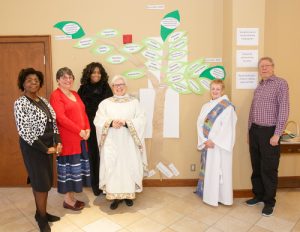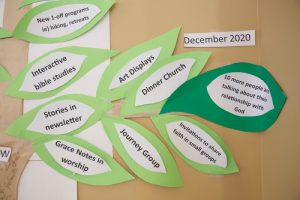By Stuart Mann
Janet Tennant says the diocese’s Mission Action Planning process has not only helped her church but revived her faith. “I feel like I’m part of an active Christian community instead of just a Christian on my own, out in the world.”
Ms. Tennant is a member of St. George, Pickering Village in Ajax, a church that has struggled over the past few years with declining attendance and shrinking finances.

A little over a year ago, the church contacted Janet Marshall, the director of the diocese’s Congregational Development department. Ms. Marshall, who had recently started in the job, was launching a program called Mission Action Planning.
“She came to a meeting of our Advisory Board and presented it to us,” recalls Ms. Tennant. “We didn’t realize we were going to be the first ones using it, but once we heard about it, we thought it was a good idea.”
A year later, the church has clear goals for both spiritual and numerical growth, a greater understanding of its neighbourhood, a deeper prayer life and a renewed sense of purpose. “We’re more aware of where we are being called,” says Ms. Tennant.
Mission Action Planning (MAP) is a process that helps parishes set goals and work toward them within a defined time period. Working from their greatest strength, churches take a “missional stretch” that will connect them to their neighbourhood, making relationships with people for the sake of sharing the gospel.
Four parishes in the diocese have completed the process, with another 12 underway or slated to begin in 2020. Congregational Development has 26 trained volunteers to help facilitate the process in the parishes.
Ms. Marshall says Mission Action Planning has come at the right time for the diocese. “We’re in a situation right now where all of our churches know that that they need to be stretching themselves in mission,” she says. “We need to imagine creative new ways to share the gospel with our neighbours, to speak the truth of the gospel in ways that people hear and draw close.”
Anglicans in the diocese are yearning to do this, she says. “We’re living in a world that can often feel complicated, chaotic and even cruel, and everybody I meet when working with parishes wants deeply to be able to stretch out with the compassion, kindness, justice and care that Jesus offers.”
She says Mission Action Planning can help parishes do that. “No process is perfect, but if a congregation spends some time and energy in prayer and reflection on themselves and God’s call to them, then we can help them take the next steps.”
MAP can take three months to a year to complete, depending on how much planning and discernment the parish has already done. The process is guided by a trained facilitator from outside the parish, to achieve the best results. Each parish is asked to form a steering committee to assist with decisions and help coordinate activities.
The process comprises three phases. In the first, the church learns more about its surrounding community. “We want to deepen our understanding of who is living in the neighbourhood, not just for today but in five or ten years from now,” explains Ms. Marshall. This can happen in several ways, including prayer walks, conversations with neighbours and commissioning an Environics study.
Ms. Tennant says this part of the process was illuminating. “The demographics in our parish had changed quite a lot over the past few years and we weren’t really sure who was in our neighbourhood,” she says.
The Environics study revealed that the average of age of local residents was quite high, there weren’t a lot of children in the neighbourhood, and that many people lived in multi-generational households. A key finding was that a lot of residents were seeking a spiritual connection – something that would play an important part in St. George’s planning.

“We thought, there are some spiritual needs that we can fulfil and we have to start thinking more seriously about that,” recalls Ms. Tennant.
The second phase of MAP involves identifying the church’s ministries and then focussing them so they better connect with the surrounding community and the church’s mission. “Many churches have inherited a lot of activities and they’re all over the place,” explains Ms. Marshall. “This puts them into place.”
Ms. Tennant says this phase, which included input from many parishioners, helped St. George’s set clear goals. “We were able to see what was important to us.”
The third phase of MAP is the “missional stretch,” where the church is encouraged to go beyond what it is currently doing. “It’s about doing something audacious in their neighbourhood – stretching themselves from what they’re already feeling confident about,” says Ms. Marshall.
The missional stretch need not be scary because the church is working from its strength, she adds. “It’s about moving out from that which you already feel most confident about.”
The missional stretch can take many forms. One church had a group of women who made prayer shawls and caps for chemotherapy patients. Confident enough to reach out into the community, they rented a table at a local farmer’s market. In addition to making their creations, they taught young women how to crochet, forming friendships with them.
For some churches, the missional stretch involves working on their own discipleship. After looking at the Environics study and its own ministries, St. George’s realized it could connect with the surrounding community through its faith formation activities. But first it had to strengthen the spirituality of its own members.

“We needed a strong core first,” explains Ms. Tennant. “We needed to focus on our own spiritual development and connection with each other. We’ll be attractional to the wider community if we can truly be disciples.”
The church has set itself three main goals, which it hopes to achieve by December 2020:
- “Deepening and enriching our spirit.” Twenty more parishioners will attend at least one new activity.
- “Strengthening our Sunday morning congregation.” Twelve more parishioners will come regularly to worship God and nurture their souls.
- “Becoming disciples of Christ and talking about our faith.” Ten more parishioners will talk about their relationship with God.
The goals, which are displayed on a paper tree at the back of the church and printed on a bookmark, are already producing results, says Ms. Tennant. “We’ve seen new people come out for Bible study, for our weekly meditation and for coffee hour. We’re seeing more people at our Sunday morning worship service, and some have stood up to tell us how they’ve talked about our church with others.”
One thing that Ms. Tennant is seeing and hearing a lot more of is prayer. “Because we made prayer a focus, we now start every meeting with prayer. People are praying a lot and you can sense that support in the church.” The entire process at St. George’s was undergirded by prayer, as it was in the other participating churches.
Ms. Tennant says the process has given St. George’s parishioners a renewed focus and purpose. “I think sometimes you go to church, attend the service and then go home and that’s you done for the week. But this whole exercise has kept things top of mind for people. People are realizing that they can have an impact, that they can actually make something change.”
Ms. Marshall has heard similar comments from other churches. “There is something about how MAP is worked on that invites leadership and congregations to understand that this is a fullness of time moment for them. It’s time to truly to take up the opportunity and challenge of stretching themselves further than they have imagined, of asking more of themselves than they have before, of setting a bar and saying, ‘With God’s help, we can do this together.’
“We don’t enter a MAP process with any judgement as to where that bar needs to be,” she adds. “That’s entirely between the congregation and facilitator, to set goals the congregation knows it can achieve, because what we’re wanting to do here is rebuild confidence and hope in our discipleship in a practical way.”
For more information on Mission Action Planning, contact Janet Marshall at jmarshall@toronto.anglican.ca.